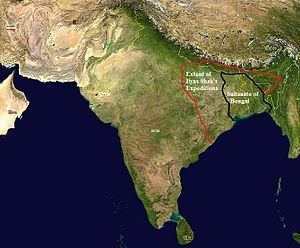Reign 1342–1352 Name Shamsuddin Shah Children Sikandar Shah House House of Ilyas Shah | Issue Sikandar Shah Parents Sikandar Shah Reign 1352–1358 Died 1358 | |
 | ||
Predecessor Sultan Alauddin Ali Shah of the Kingdom of Lakhnauti Predecessor Sultan Ikhtiyaruddin Ghazi Shah of the Kingdom of Sonargaon | ||
Shamsuddin ilyas shah
Shamsuddin Ilyas Shah (Bengali: শামসুদ্দীন ইলিয়াস শাহ) was the first Sultan of Bengal and founder of the Ilyas Shahi dynasty, which lasted for nearly one hundred and fifty years. A Sunni Muslim of Sistani Afghan origin, he unified the Bengal region into an Islamic kingdom during the 14th century. Popularly known as Ilyas Shah, he waged military campaigns across the eastern Indian subcontinent and defeated the rulers of Delhi, Sonargaon, Satgaon, Nepal, Orissa and Assam. Based in Pandua, his campaigns reached as far as the Kathmandu Valley, Varanasi, Gorakhpur, Champaran and Cuttack. His campaigns were considered "world-conquering" in the context of medieval India. Ilyas Shah has been described as the Bengali equivalent of Alexander or Napoleon.
Contents

The Bengal Sultanate established by Ilyas Shah emerged as one of the leading diplomatic, economic and military powers in the subcontinent. The dynasty founded by him ruled Bengal for 125 years. Ilyas Shah and his successors embraced Indo-Aryanization and adapted themselves to Bengali culture and society. Their kingdom was a melting pot for migrants from across the Muslim world. It played a key role in the development of Bengali Muslim society. He formed an inclusive and pluralistic administration. His most important legacy is that of the first independent unified Bengali kingdom under Muslim rule.
Early life
Shamsuddin Ilyas was born into an aristocratic family in the Sistan region of what is today eastern Iran and southern Afghanistan. He worked under the service of the Delhi Sultanate. He migrated to Bengal and worked under Izzuddin Yahya, the imperial provincial governor of Satgaon.
Unification of Bengal
By the mid 14th century, three Muslim city states emerged in Bengal after declaring independence from the Delhi Sultanate: Lakhnauti (ancient Gauda) in North Bengal, Sonargaon in East Bengal and Satgaon in South Bengal. In 1338, after Izzuddin Yahya's death, Ilyas declared himself as the Sultan of Satgaon, with the title Shamsuddin Ilyas Shah. He then waged a long drawn war from 1339 to 1352 against Sultan Alauddin Ali Shah of Lakhnauti and Sultan Ikhtiyaruddin Ghazi Shah of Sonargaon. Ilyas Shah emerged victorious after conquering Lakhnauti and Sonargaon. He then proclaimed the establishment of the Sultanate of Bengal in Lakhnauti in 1352. The area was the former capital of the Gauda Kings and the Pala Emperors. He built his capital in nearby Pandua.
Government
Ilyas Shah displayed a liberal attitude towards his subjects. His administration was known for its equality and members from different religious, caste, social and ethnic communities. Ilyas Shah also founded the city of Hajipur. He patronized Sufism. The people of Bengal came under the banner of one politico-social and linguistic platform, including the Bengali language. The region received immigrants from across the Muslim world, including North Indians, Turks, Abyssinians, Arabs and Persians.
Military campaigns
During the early period of his reign, Ilyas Shah led the first Muslim army into Nepal. He occupied the Tirhut region and made a bold thrust through the Terai plains into the Kathmandu Valley. His army sacked the temple of Svayambhunath., returning to Bengal with immense booty. Ilyas Shah then invaded Orissa, which was ruled by Bhanudeva II of the Eastern Ganga dynasty. He sacked Jajpur, Cuttack and reached as far as the Chilika Lake. He also led a successful campaign against the Kamarupa kingdom in present-day Assam.
In November 1353, the Delhi Sultan Firuz Shah Tughluq launched an invasion of Bengal. His army occupied Pandua. Ilyas Shah and his forces retreated to the fortress of Ekdala. The Delhi Sultan laid siege to the fortress for two months. The Delhi Sultanate's forces then began withdrawing. Ilyas Shah began to pursue Delhi army and reached as far as Varanasi. The Delhi army formidably fought back. Firuz Shah returned to Delhi in 1355. Ilyas Shah regained control of Bengal and his realm extended up to the Koshi River.
The extent of Ilyas Shah's campaigns, including his conquest of major Indian cultural centers, were considered "world-conquering" in the context of medieval India. This led to him styling himself as "the second Alexander".
